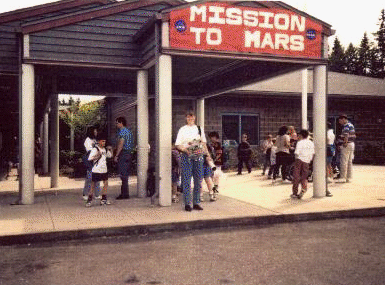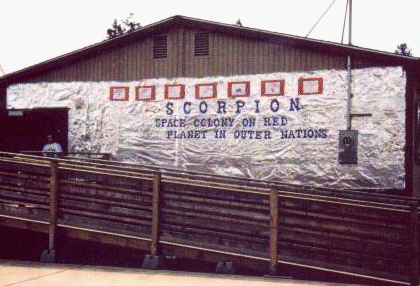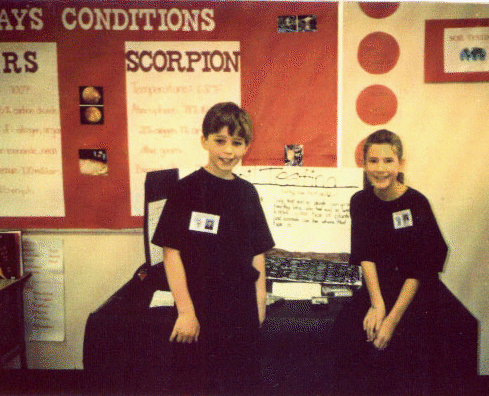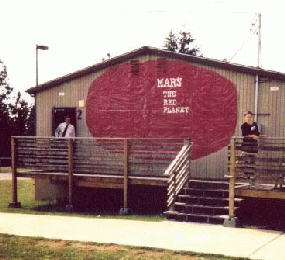Brigitte McAllister
Mission to Mars
Cedar Wood Elementary
Bothell, WA
[Exemplary Programs] -
[Cedar Wood Elementary] -
[Mission to Mars]
Overview
Cedar Wood elementary school conducted its second 24 hour
simulated space launch in May of 1994, led by Fran O'Rourke. Brigitte
McAllister's fifth grade class participated in this project by
simulating a mission to Mars. For this mission, her class transformed
one portable into the planet Mars and another into a Mars
colony.

(Photo
courtesy of Brigitte McAllister)
Preparation
Five months were spent preparing for this project. The students:
- Built and launched model rockets
with the help of Boeing engineers.
- Researched Mars and
past, present, and future space missions.
- Heard a graduate student from the University of
Washington gave a presentation on Mars.
The students then decided the areas of space exploration that interested them and
put together display proposals for the grand event in late May. All the
remaining students in the school had the opportunity to visit the student-developed
stations in the simulations of Mars and the Mars colony.
The students decided to display six stations
- Space Colony
- Soil Testing
- Growing Plants on Other Planets
- RAM Accelerator
- Astronaut Training
- Biomedical Research

(Photo courtesy of Brigitte McAllister)
An informational packet entitled "Space Station: K-5 Hands-on Science
and Math Lesson Plans" was obtained from Boeing. For this mini unit
the students learned about the purpose of space stations and colonies.
They wrote a report about Salyut, Skylab, and Mir. The students also
learned about the configuration of a space station/colony,
specifically the laboratory and habitat modules. Each of the students
then constructed a mini space station using paper. A team of six
students built a model of the space colony that the portable
represented. They named it S.C.O.R.P.I.O.N., which stands for Space
Colony on Red Planet in Outer Nations. During the day of the
simulated space launch, each member of this team shared their
knowledge of space colonies with the other students who visited the
portable.

(Photo courtesy of Brigitte McAllister)
The students who represented this
station were given a science kit with all the necessary
materials to test soil. First, the students had to
research the properties of soil. This team also
researched the Viking mission and discovered that
Martian soil contained no organic material. These
students then conducted the soil tests for the students who
visited this station.

The students wrote to Oracle, Arizona, and Epcot
Center to obtain information on growing plants in
space. Research on the Biosphere II project and
Epcot's research in "The Land" became a vital part of
our project. We also obtained information from
Bottle Biology Project and Wisconsin Fast Plants to
learn how plants can grow from recycled material.
As a result of our research, we were able to build a
model of a biome from the Biosphere II project. The
team of students who represented this station
discussed with visitors the possibilities of growing
plants on other planets. A video of the Biosphere II
project was also played throughout the day.
In preparation for our
Mars project, my class went on a field trip to the
University of Washington's Aerospace Research
Center. While there we learned about the Ram
Accelerator and were given the opportunity to view
it. A team of my students then built a model of the
RAM Accelerator and prepared a summary of its
future use. During the day of the simulated space
launch, this team of students shared with visitors how
the RAM Accelerator will hopefully launch payloads
into space. They discussed how this can be possible
without the use of a space shuttle, making it a much
more economical way of transporting materials.
Video footage of astronaut training centers provided the students with
a good understanding of all that is involved. Students understood the
effects of microgravity, for example. They also became familiar with
training that was done in underwater tests, which were designed to
simulate conditions in space. Some research was also done on an
international team that spent six months in Antarctica. The students
presented this information and provided visuals. This team also
studied the various ways the astronauts traveling to and from Mars
could maintain strong muscles. An exercise training program seemed to
be the most logical answer, but the students did not rule out the
possibility of building a space vehicle that simulates gravity.
This station was
visited by more students than any other station. Two
registered nurses helped the students in this station in
several ways. The nurses brought in several types of
equipment and trained the students how to use them
as well as how to interpret the results.
The students
also did research on the effects of microgravity on
the human body. The students discussed various ways of
combating nausea, loss of appetite, and vomiting
while in transit to Mars. They also discussed the
affects of living on Mars.
Their primary purpose was
to monitor the health of the colonists. Each student
who visited this station was given a brief "physical".
In addition to this, each student was weighed and was
told how much he or she would weigh on Mars.
Results
Nearly 600 students toured the portables and as a
result gained much information about Mars and space
related topics. The students were eager to learn about
their topics because it was a hands-on project and not
another paper and pencil assignment. They were
enthusiastic about becoming experts in their fields
and sharing their knowledge with other students. As a
result the students who visited the stations saw
visuals, experiments, and actually learned from their
peers. Overall, the project was a tremendous success
and served as a nice addition to the other projects
presented by other classrooms.








